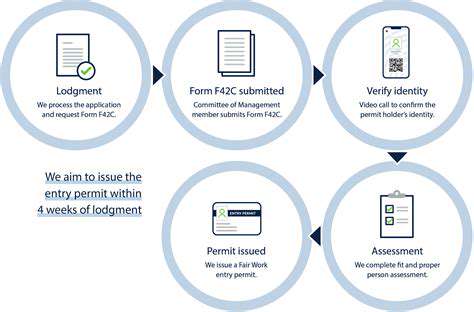Tips for a Smooth Customs Experience
Packing Smart for a Hassle-Free Customs Check
Understanding Customs Regulations
Navigating customs regulations can feel daunting, but understanding the basics is key to a smooth experience. Researching the specific regulations for the country you're traveling to is crucial. Knowing what items are prohibited or restricted, and what documentation you might need, can save you significant headaches and potential delays at the border. This includes knowing about specific rules regarding electronics, food products, or even certain types of clothing that might be restricted in your destination country.
Different countries have varying rules, so thorough research is essential. Don't rely solely on general information; consult official government websites for the most up-to-date and accurate details. This proactive approach will minimize surprises and ensure you're prepared for any questions or inspections.
Packing Strategically for Liquids and Aerosols
Packing liquids, aerosols, and gels can be tricky. To avoid issues, ensure you adhere to the 3-1-1 rule, which typically limits liquids to 3.4 ounces (100ml) per container, placed in a single, clear, quart-sized, zip-top bag. This is a standard practice in many countries to prevent security risks and ensure smooth customs processing.
Understanding the specific regulations for your destination is vital. Some countries may have more stringent rules. Double-checking the guidelines, especially for sensitive items like medications or special dietary requirements, is essential to avoid problems.
Properly Documenting Your Possessions
Thorough documentation of your belongings is essential. If you're transporting expensive items or antiques, consider having them professionally appraised. This documentation can be crucial if questioned by customs officials. Be sure to keep receipts for purchases, especially if you're bringing items that might raise questions.
Preparing for Electronics and Valuables
When packing electronics, consider the potential need for import permits or customs declarations. This is especially important for high-value items. Research any specific regulations regarding electronics, such as phones, cameras, or laptops, in your destination country. Always check the rules for bringing in or out electronics, as they vary greatly by destination.
Packing Medications and Dietary Needs
If you're taking prescription medications, ensure you have the necessary documentation, such as a prescription or a letter from your doctor, confirming the medication's purpose. This will help expedite the customs process and prevent any issues. Additionally, if you have specific dietary requirements, ensure you have the necessary documentation and be prepared to provide information about your needs.
Using Secure Packaging and Labeling
Employing secure packaging and clear labeling is crucial for protecting your belongings and avoiding potential issues. Use sturdy containers to prevent breakage during transit. Clearly label all items with your name, contact information, and the contents to facilitate quick identification and prevent confusion.
Understanding Restricted Items and Prohibited Substances
Familiarize yourself with the list of restricted and prohibited items in your destination country. This includes anything from specific food products to certain plants or animals. Researching these items beforehand will prevent unnecessary delays or penalties at customs. Always double-check with the relevant authorities for the most recent details on restricted or prohibited items.
Preparing Your Documents for a Swift Clearance
Understanding the Clearance Process
A swift clearance process hinges on meticulous preparation. Understanding the specific requirements for your documents is paramount. This involves not only knowing what documents are needed but also comprehending the format, language, and any specific details or attachments mandated by the customs authority. Thorough research into the requirements for your destination and the type of goods being transported is essential for a smooth and efficient clearance.
Failure to comply with these requirements can lead to delays, and in some cases, rejection of your shipment. Taking the time to fully understand the clearance process and the necessary paperwork will save you time, stress, and potential costs down the road.
Accurate Documentation is Key
Precise and accurate documentation is critical for a swift clearance. Inaccuracies or omissions can lead to delays and scrutiny from customs officials. Ensuring all details, including quantities, descriptions, values, and origin, are accurately reflected in the documents is paramount. Double-checking for any errors or inconsistencies is an essential step in the preparation process.
Each document should be reviewed meticulously for accuracy and completeness before submission. This meticulous approach will minimize potential issues during the clearance process and ensure a smoother experience.
Proper Packaging and Labeling
Proper packaging and labeling of your documents, and the goods themselves, are crucial for a swift clearance. Clear and visible labels that include all necessary information, such as the consignee's details, the commodity description, and the shipping information, are essential. This ensures that customs officials can quickly and easily identify the contents of your shipment.
Ensure that the packaging is appropriate for the goods and meets any specific requirements outlined by the customs authority. This will save time and prevent potential issues with damaged or misplaced documents during transit.
Compliance with Regulations
Adherence to all relevant regulations and guidelines is essential for a smooth customs clearance. This includes understanding the import and export regulations of both the origin and destination countries. Familiarizing yourself with these regulations will help you avoid any potential penalties or delays.
Staying updated on any changes or revisions to the regulations is equally important. Customs regulations can change frequently, so staying informed will minimize the risk of encountering unexpected issues during the clearance process.
Preparing for Inspections
Anticipating potential inspections and having the necessary documents readily available is crucial. Anticipating questions or requests from customs officials and being prepared with the relevant information will expedite the process. Having a clear understanding of what to expect during an inspection will help manage any potential stress and maintain a positive interaction.
Utilizing Technology for Efficiency
Leveraging technology to streamline the document preparation process can significantly expedite the clearance process. Using digital tools and software solutions can help automate parts of the process, reduce errors, and improve overall efficiency. This can save time and resources, especially for large shipments or complex procedures.
Employing electronic document management systems and utilizing online customs portals can be a huge time saver and can help to ensure all documents are submitted correctly and on time.
Knowing the Customs Rules of Your Destination

Understanding the Importance of Customs Rules
Navigating international trade requires a deep understanding of customs rules, which are regulations enforced by individual countries to manage the import and export of goods. These rules are crucial for ensuring compliance with trade agreements, protecting domestic industries, and collecting revenue for the government. Failing to comply with customs rules can lead to significant penalties and delays in the delivery of goods. Understanding these rules is essential for businesses engaged in international trade to avoid costly mistakes.
Classifying Goods for Customs Purposes
A critical aspect of customs rules involves classifying goods according to specific codes in the harmonized system (HS). This classification is essential for determining the appropriate tariffs, taxes, and regulations that apply to imported or exported goods. The correct HS code ensures that the goods are subject to the correct duties and avoids delays or penalties. Accurately classifying your goods is paramount for smooth and compliant international trade. Proper categorization is necessary for adherence to trade agreements and to avoid potential legal issues.
Documentation Requirements for Customs Clearance
Customs clearance procedures often require specific documentation, such as commercial invoices, packing lists, and certificates of origin. These documents provide critical information about the goods being imported or exported, including their value, description, and origin. Accurate and complete documentation is essential for ensuring smooth customs clearance. Failure to provide the required documentation can lead to delays and potential rejection of the shipment.
Tariffs and Taxes on Imported Goods
International trade often involves tariffs and taxes levied on imported goods. These charges vary significantly depending on the country and the specific goods. Understanding the tariffs and taxes applicable to your goods is vital for accurate financial planning and cost management. Thoroughly researching and calculating these costs is crucial to avoiding unexpected expenses and ensuring the profitability of international trade transactions.
Export Regulations and Restrictions
Export regulations often dictate which goods can be exported, the required documentation, and any restrictions on export quantities. These regulations are crucial for complying with international trade laws and avoiding penalties. Be aware that certain goods might be subject to export controls or restrictions, such as dual-use items or those with national security implications. Therefore, businesses involved in exporting need to thoroughly research and understand the specific export regulations of the countries they are dealing with to avoid complications and ensure the smooth flow of their goods.
Understanding the Importance of Clear Communication

Understanding the Significance of Cleanliness
Cleanliness, often taken for granted, plays a crucial role in maintaining a healthy and productive environment. From personal hygiene to maintaining a pristine workspace, the impact of cleanliness on well-being is undeniable. It fosters a sense of order and calm, reducing stress and improving overall mental clarity. A clean environment encourages focus and efficiency, essential for success in any endeavor.
Implementing simple cleanliness practices can significantly improve the quality of life. Regular cleaning routines, whether for the home or the workplace, promote a healthier atmosphere, minimizing the risk of illness and creating a more inviting space for both individuals and visitors.
The Impact of Clutter on Productivity
Clutter, in contrast to cleanliness, can have a detrimental impact on productivity and well-being. A cluttered workspace, for example, can lead to decreased focus, increased stress, and ultimately, decreased efficiency. This disorganization can manifest in missed deadlines and diminished output. The mental effort required to navigate and manage a cluttered environment diverts energy from more important tasks.
Clearing clutter isn't just about aesthetics; it's about creating a space conducive to concentration and creativity. Decluttering allows for a clearer mind, fostering a more productive and fulfilling work environment.
Maintaining Cleanliness in Different Environments
The importance of cleanliness varies depending on the environment. Maintaining a clean home is vital for family well-being, promoting a safe and comfortable living space. A clean home fosters a sense of security and belonging, particularly for children. Similarly, a clean workplace fosters a productive and professional atmosphere for employees and clients alike.
Cleanliness in public spaces, such as parks and community centers, is crucial for maintaining a healthy and inviting environment for everyone. Maintaining clean public spaces cultivates a sense of community pride and promotes a healthy environment for all.
The Connection Between Cleanliness and Health
The link between cleanliness and health is undeniable. Regular cleaning routines help prevent the spread of germs and bacteria, thus reducing the risk of illness and promoting overall health. Maintaining hygiene standards, whether personal or environmental, safeguards against the transmission of contagious diseases. This is particularly important in public spaces and healthcare settings.
From handwashing to thorough cleaning of surfaces, these practices are essential for safeguarding health and preventing the spread of illnesses. Cleanliness is a fundamental aspect of preventing the spread of disease, especially in times of potential outbreaks.
Cleanliness and Personal Well-being
Cleanliness extends beyond the physical environment; it significantly impacts personal well-being. Maintaining personal hygiene, such as regular bathing and handwashing, fosters a sense of self-respect and confidence. This personal care routine contributes to a positive self-image and overall emotional well-being.
A clean and organized environment can reduce stress and promote feelings of calm and tranquility. This can have a positive impact on mental health and overall well-being.
The Role of Cleanliness in Business
Cleanliness is increasingly recognized as a crucial aspect of a successful business. A clean and well-maintained workspace projects professionalism and enhances the company's image. It promotes a positive impression on clients and customers, fostering trust and confidence. Cleanliness can significantly influence customer perception and contribute to a positive brand image.
Furthermore, a clean and organized workplace can boost employee morale and productivity. Employees working in a clean and tidy environment are often more focused and motivated, leading to increased efficiency and overall performance.
The Importance of Sustainable Cleanliness
Beyond immediate benefits, sustainable cleanliness practices are becoming increasingly crucial. Adopting environmentally friendly cleaning methods and products reduces the negative impact on the environment. Using eco-friendly cleaning products minimizes the risk of harming ecosystems and preserves natural resources.
Implementing sustainable practices not only benefits the planet but also demonstrates corporate social responsibility and strengthens a company's reputation. Choosing eco-friendly cleaning products and minimizing waste are essential steps in fostering a sustainable approach to cleanliness.


![Exploring the Temples of Southeast Asia [Cultural Guide]](/static/images/27/2025-05/Myanmar27sGoldenPagodas3AASymphonyofSpirituality.jpg)
![Tips for Flying with Kids [Stress Free Guide]](/static/images/27/2025-05/PlanningAheadforaSmoothFlight3APre-TripPreparation.jpg)







![Tips for Traveling as an LGBTQ+ Couple [Safe Destinations]](/static/images/27/2025-07/PrioritizingSafetyandSecurity.jpg)
![Tips for Traveling with Toddlers [Survival Guide]](/static/images/27/2025-07/NavigatingTransportationwithYoungChildren.jpg)